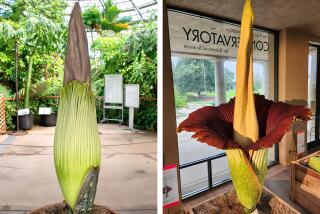Christmas on the patio
At any other time of year, it’s easy to miss the beauty of the jumbled little Christmas cactus -- such a funny-looking bit of green chaos with its flat, oval-segmented stems that go willy-nilly, this way and that. Until, that is, the buds tipping the stems pop open during the holidays. Vibrant, exotic flowers appear en masse -- just at the time of year we most need a boost of color -- and you realize this plant is, quite simply, magical.
Schlumbergera (also called zygocactus) is an epiphyte that grows wild in the crooks of trees in the jungles near Rio de Janeiro, and in California it can thrive in pots -- on patios or in the living room -- for decades, if treated right. A true cactus, the schlumbergera has no prickly spines but is made up of oval pads that are joined together in a way that resembles, depending on its habit, a slouchy bunch of crab claws or a floppy, multi-limbed robot a child might have cobbled together from a kit.
But when these plants are in full bloom, beginning around Thanksgiving until the end of the year, the eye skips right over the foliage and sees little but the fireworks-style bursts of color.
In most nurseries this time of year, you’ll find Schlumbergera buckleyi, a species with smooth, rounded segments, and Schlumbergera truncata, one with toothed segments, in full or partial bloom -- usually with red, white or pink flowers. If you look around, you might be able to find newer shades of orange, lavender and -- if you’re lucky -- the elusive yellow. Small plants make nice, inexpensive gifts that will grow quickly.
Whether buying big or small, look for plants with blooms as well as some buds to ensure a longer flowering time. If it’s a certain color you’re after, search for and buy it now; once the exquisite blooms are off, sometime in January, the plants all look the same (and you can’t always count on nursery tags). But beware: Collecting them can be addictive.
Ursula Pettigrew has 50 schlumbergera plants in her Bay Area home and is on the prowl for more. She’s a member of EpiForums ( www.epiforums.com), an online community of epiphytic enthusiasts. She and others share pictures of their blooms, ask questions, offer advice and try to sweet-talk members into sharing cuttings of special plants. She is the proud owner of a rare Schlumbergera orssichiana, a type with extra-large flowers and whose source has apparently disappeared because of deforestation in Brazil, and a hybrid with variegated segments. “There are so many slight differences between varieties,” Pettigrew says, “but as a collector you want them all.”
Schlumbergera plants form buds when the hours of daylight are short. The blooms last longer at temperatures between 45 and 70 degrees. Some commercial growers, as well as individuals, try to manipulate the timing with light and temperature. Dave Bernstein, owner of California Nursery Specialties Cactus Ranch in Reseda, says you can play with the timing a bit, but he also notes that our Southern California conditions “are naturally perfect to get flowers for the holidays. Some varieties -- his nursery stocks several dozen kinds -- “are bound to bloom earlier; it’s in their heredity,” he says, whereas others will always bloom a little later. With marketing more in mind than political correctness, he suggests calling the plants “holiday cacti.”
Kept in the garden or inside the house, schlumbergera plants do well with little attention, Bernstein says. “They can grow in Palm Springs to the coldest areas with some protection,” he says. Just don’t let them freeze or get too much direct sunlight. Forced indoor heating isn’t good for them either. And while it’s OK for the soil to dry out (stressing them beginning in September will actually help bud formation), make sure they’re watered regularly once the buds -- and later, the flowers -- appear. Regular fertilizing is a good idea, he adds, as is pinching off faded blooms. If the plant flowers in September as well as the spring, be happy; but understand that it’s a cousin, hatiora (also known as rhipsalidopsis or Easter cactus), not a schlumbergera.
Bernstein, who opens his wholesale nursery to the public on weekends, recommends growing both plants -- and growing them together. Alternate the schlumbergera and the hatiora in a moss-filled wire basket, he suggests, filling in with other succulents that have year-round color, such as sedum and echiveria. “You’ll have a colorful basket with bonus color at the holidays.” And though the hatiora’s flowers will be welcome in the spring and fall, it will be the bright blooms popping out on those funny schlumbergera plants in the middle of winter that you’ll celebrate most.
--
--
(BEGIN TEXT OF INFOBOX)
One’s all you’ll need, but not all you’ll have
PROPAGATING schlumbergera is simple. After the plant has finished blooming, twist off several individual oval segments from the stem and plant them in a small pot filled with slightly damp soil. “Never cut them,” says Jerry Williams, owner of Rainbow Gardens Cactus Nursery in Vista, who has propagated more than 100,000 schlumbergera cuttings. Never try to propagate from a larger cutting. “The plant can’t sustain more growth without an established root system,” he says. He recommends planting the cutting in a mixture of about half peat moss, half perlite. They’ll look a little sad until they form roots, about four to six weeks later. Once they perk up, repot, again in small pots with the same mixture. If you do this in February or March, you’ll have flowering plants by the following winter -- and holiday gifts for many on your list.
-- Christy Hobart






